
Text by MARTIN WINDROW, Color plates by MICHAEL ROFFE. YEAR 1972
THE PANZER DIVISIONS
C3 Oberfeldwebel ('Spiess'), Sturmartillerie, 1943
The 'Spiess' was not a rank, but a position within a unit - the senior N.C.O. automatically took over duties analogous to a British C.S.M., whatever his personal rank, and his position was marked by the two silver braid stripes worn on each sleeve. This C.S.M. of self-propelled artillery is in 'reporting order', with his leather-covered pouch at the ready, to report the state of the unit to his commanding officer.
The field-grey uniform worn by self-propelled artillery personnel of all classes was identical in cut to the black Panzer uniform. Note that there is no piping around the collar - this was never worn in the artillery. The grey sidecap, however, has a soutache of artillery red Waffenfarbe piping. The shoulder-straps are piped in artillery red, and one of several types of collar-patch associated with the self-propelled artillery branch is sewn to the tunic. It is the normal Army collar- bar patch of a non-commissioned officer, with an outline of red Waffenfarbe piping. This style was worn by non-commissioned ranks only - officers wore their standard collar-bars on the usual backing patch of dark bluish-green badge cloth. Other types of patch worn by these increasingly vital members of the Panzer Division included collar-bars without piping; and dark bluish-green patches with red piping edging and silvery-grey skulls, identical in design to Panzer patches. As the war progressed, however, the type of patch shown here became the most common, although all styles were often observed alongside one another. As an artilleryman this N.C.O. wears the bronze General Assault Badge rather than the Tank Assault Badge; his black Wound Badge is pinned beside it, and the ribbon of his Iron Cross 2nd Class is worn in the buttonhole.

The upper cuff-title, worn on the right sleeve, was the formation identification insignia, instituted for Afrika Korps personnel on 18 July 1941. It was replaced by the lower type, worn on the left sleeve and basically a campaign honour, on 15 January 1943; all personnel who served six months in Africa, or who were wounded in that theatre, were eligible. The small silver-grey death's-head, identical with that worn on the black collar-patches of the European tank uniform, was pinned to the lower lapel of the tropical tunic. The officer's collar-bars, worn on the collar of the field-grey uniform and the upper lapels of the tropical tunic, are in dull silver thread on a patch of bluish-green 'badge cloth'; pink Panzer Waffen-far be appears in two small strips down the centre of the bars. (Author's collection)
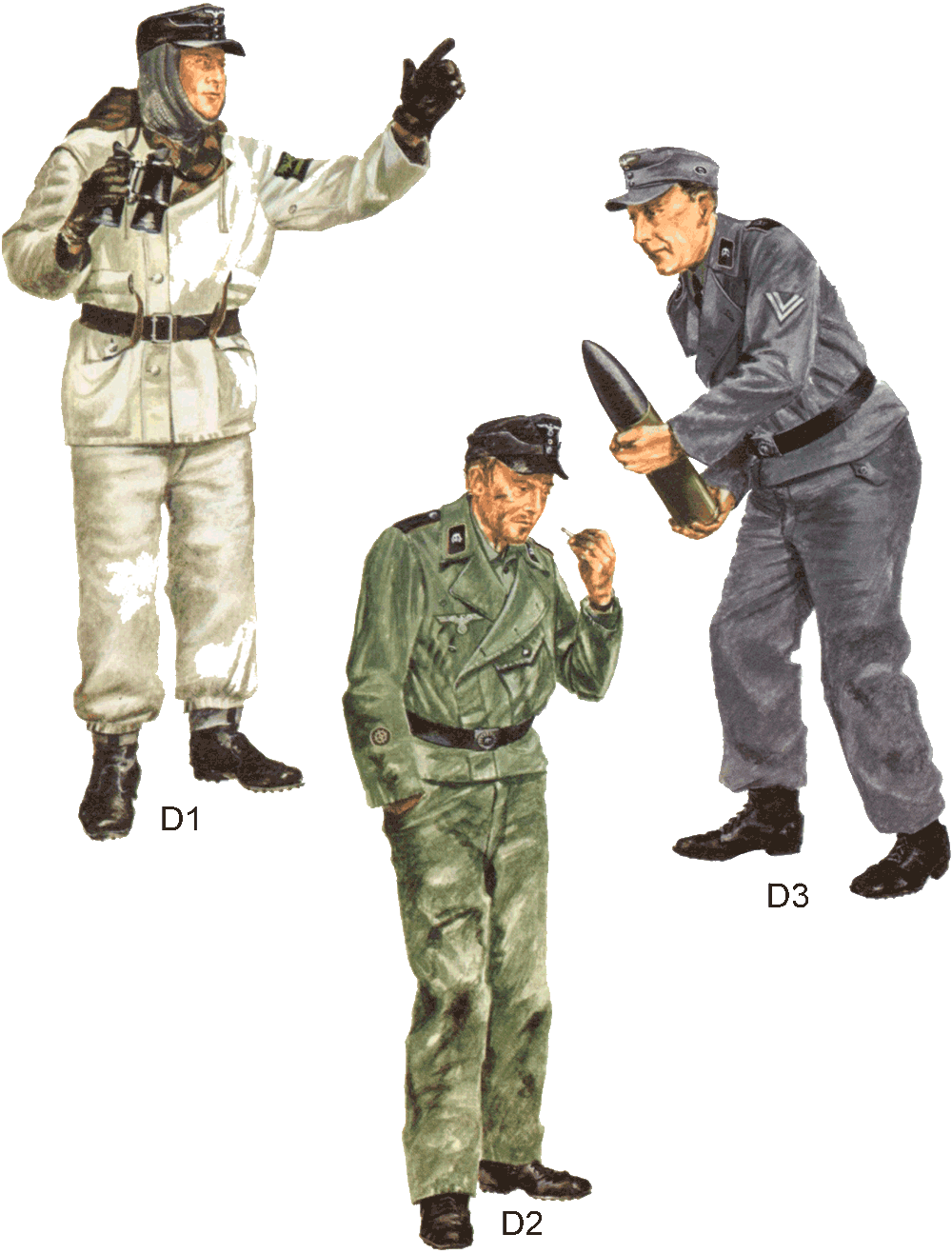
D1 Leutnant, Panzertruppen, winter 1943/4
In June 1943 the new field service cap (Einheitsfeldmütze) was authorized, and from that date it became the most widely used form of headgear in the German forces, apart from the steel helmet. Many versions appeared, differing in details. This tank troop commander wears the black Panzer pattern. As an officer he has the crown seam and the front arch of the 'turn-up' flap piped in silver; other caps observed had the crown piping only. The two small silver buttons on the flap were largely decorative, as although in theory the flap could be pulled down and worn round the face, it was more often sewn in place, for reasons of smartness.
He wears the reversible white/camouflage hooded winter smock, a bulky garment with a thick inner lining of blanket material, introduced the previous winter. Its double-breasted cut and overlapping flaps formed a windproof closure, and it was a very serviceable, comfortable, and popular garment. The 'water pattern' camouflage is visible on the reverse of the lapels and inside the hood. The stylized rank badge of a Leutnant - a single pair of oak leaves over a single bar, in green on a black patch - is worn on the left upper arm; this type of rank patch was widely used in place of all other forms of insignia on protective and camouflage clothing of all types. The heavy reversible over-trousers are fastened by drawstrings rather high on the ankle, over special felt-and-leather combination winter boots. The shapeless grey woollen toque was standard issue.
This first-class mechanic, taking a cigarette break during a round-the-clock engine job, wears the 'Other Ranks' version of the black Einheitsmütze. He is dressed in the reed-green Panzer denim suit (Schilfgrüner Drillichschutzanzug) issued to Army armoured formations as working dress. It was worn sometimes over the black uniform, and sometimes by itself as a warm-weather uniform. This soldier wears it in the latter way, over the field-grey late-issue shirt. The black leather belt and lace-up ankle boots are standard; these boots, in use since 1941, had by this stage completely superseded the marching boots for wear in the vehicle.
The denim jacket was issued with a breast- eagle in the usual Army colours of grey on sage-green. Armoured personnel usually added special insignia: the normal pink-piped black shoulder-straps, the death's-head collar-patches, and any other insignia they wished. On his right forearm this man wears the qualification badge of his trade - a field-grey circular patch with the pink cord edging of first-class grade, and the pink Zahnrad or cogwheel design.
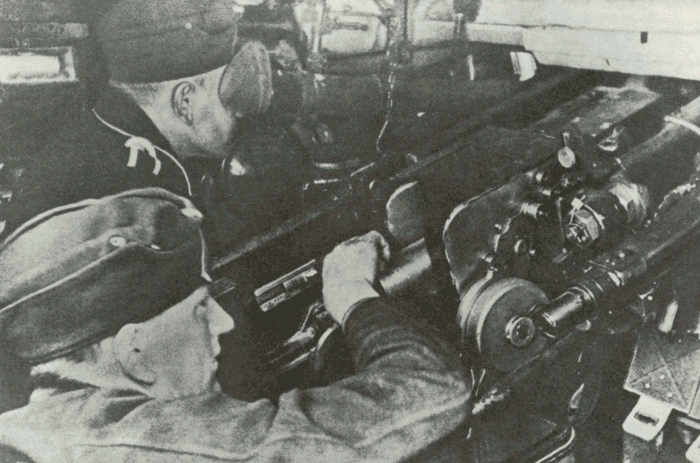
Gunner (left) and loader in action in a PzKpfw. III tank.
D3 Obergefreiter, Panzerjäger, 116. Panzer Division, 1944
As mentioned in the commentary on Plate C3, the self-propelled artillery branch became increasingly important as the war progressed. By the close of 1944 two or three companies of self- propelled 'tank destroyers', usually Jagdpanzer IVs or Jagdpanthers, were a potent weapon in the armoury of the Panzer Division. The duplication of effort involved in the manning and organization of the S.P. units by the artillery, rather than the armoured branch, caused endless frustrations, and the overlapping of command is perhaps reflected in the apparently pointless changes of insignia to which these troops were subject. As stated previously, the final form (in theory) was for these troops to wear normal Army collar-bars with red Waffenfarbe edging for non-commissioned personnel, but uniformity was never really achieved.
This corporal wears a popular variation which emphasized the marginal difference between the crew of a Panther tank and the crew of a Jagdpanther of the same division, perhaps operating within half a mile of each other. He wears the field-grey uniform of the artillery vehicle crews, of identical cut with the Panzer suit. His collar- patches are the black, pink-piped tank crew pattern. His shoulder-straps are likewise of Panzer pattern, distinguished only by the pink Gothic 'P' (for Panzerjäger). His breast-eagle and rank chevrons are of standard Army pattern.
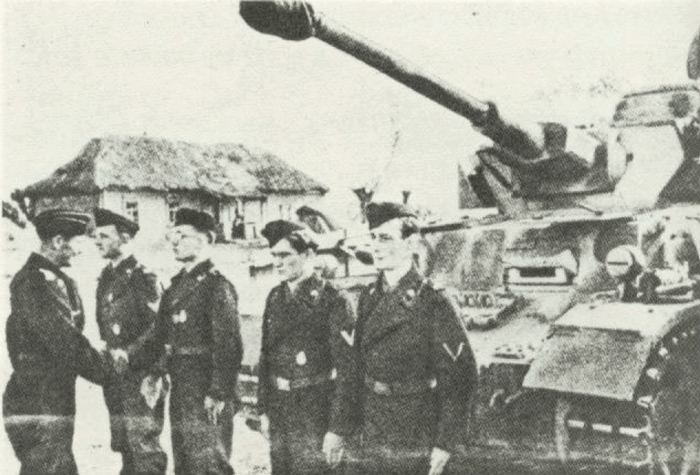
Congratulations for the crew of a PzKpfw. IV tank in Russia. (Imperial War Museum)
On the left side of his field-grey Einheitsmütze appears a small black and white enamel badge bearing the greyhound insignia of the 116th Division. In the closing months of the war such divisional emblems, while not common, were increasingly adopted by a few elite formations. On the peaked service cap they were worn beneath the eagle badge and above the oak spray.
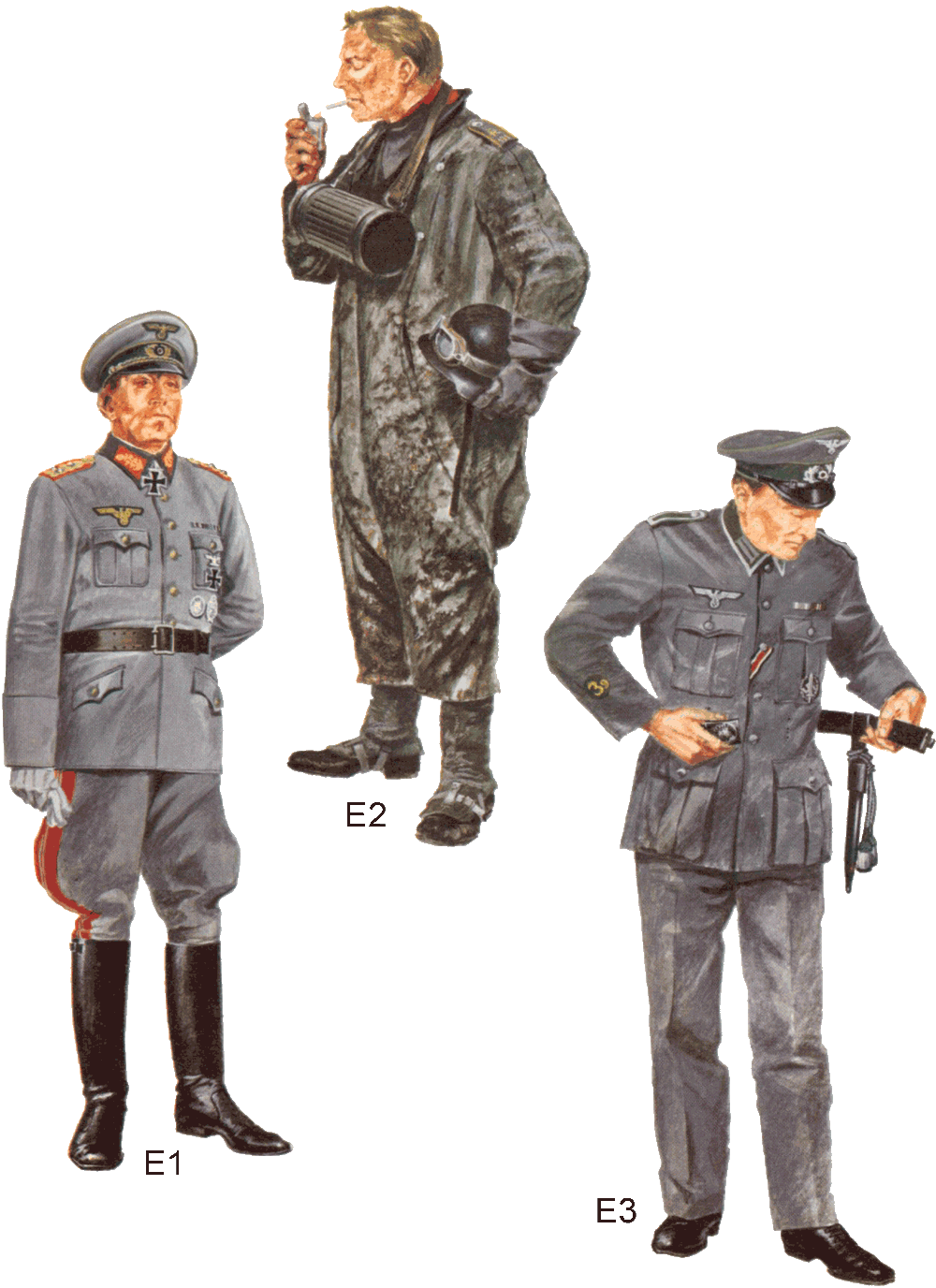
E1 General der Panzertruppen, 1943
One of the architects of the Panzer arm, in normal General's service dress. The peaked cap, of fine-quality material, is field-grey - but slight variations in shade were common with items of this quality, a comment which applies with equal force to the tunic and breeches. The band is dark-green velvet, and the piping around crown seam and band is gold metallic thread. The eagle badge is woven in gold thread on a dark-green background; pressed gilt metal eagles were also common. (Before January 1943 the insignia on the General's cap were in silver metal or thread, although the other gold distinctions accompanied them.) The oak-leaf spray surrounding the national cockade is also in gold, as are the two cords.
The fine-quality tunic, frequently of a rather pale shade and sometimes almost approaching a blue-grey rather than a green-grey colour, has four pockets; the large pleated breast-pockets are external, the lower pair internal with slanted flaps. All buttons on the tunic are of gilt metal. The national emblem above the right breast-pocket is woven in gold thread on a dark-green ground. The turn-down collar is of dark-green cloth, with the large red collar patches of General's rank, embroidered in gold with the traditional oak-leaf motif. The red shoulder-strap underlay is common to General Officers of all branches; it bears a heavy plaited motif in mixed gold and silver cord, and two silver pips. The pegged breeches have the broad red stripes of General's rank down the outer seam - actually a thin line of red piping follows the seam itself, with a broad red stripe on either side.
The Ritterkreuz is worn at the throat. On the left breast are the 1939 Bar to the 1914-18 Iron Cross; the Iron Cross 1st Class; the 1914-18
Wound Badge in silver; and one of the rare (ninety-nine only) First World War Tank Assault Badges. This decoration was awarded in 1921 to crew members of tanks who had taken part in three or more actions during the First World War - an exclusive band indeed.
E2 Kraftradfahrer, Aufklärungstruppen
The mobility of the Panzer Division was only possible if advanced reconnaissance and internal control were maintained at all times. Motorcycle units were used in a variety of roles, including armed light reconnaissance, as well as providing a useful means of mobile liaison. For the protection of the motorcycle riders the German Army produced a voluminous coat of rubberized fabric, illustrated here as worn by a reconnaissance unit motor-cyclist after a hard journey in the Russian thaw. The full skirts of the coat could be pulled back between the legs and buttoned around the calves, giving warmth and protection while riding astride the bike. This is the reason for the somewhat 'pregnant' appearance of the rider - the cut of the coat when buttoned in this way is intended to allow comfort in the sitting position, not elegance when standing!
The coat has a broad turn-down collar of field- grey woollen material, and two pairs of silver-grey buttons on the chest; it is double-breasted for greater wind protection. No collar-patches are worn. The wrists have tight-buttoning bands, and there are two side-pockets, opening almost vertically. Civilian scarves were widely used throughout the Wehrmacht in the field. The gas-mask canister was worn around the neck by motorcyclists. The normal shoulder-straps are looped and buttoned to the coat - in this case piped in cavalry yellow, typical of a recce unit. Although such decorations would seldom be seen in the field, we have included in our figure the motorcyclist's shoulder tally - a Gothic 'K' (for Kraftrad) above his Abteilung number, both woven in the Waffenfarbe of the branch to which he is attached. Note the strapped leggings of canvas and leather worn over the boots.
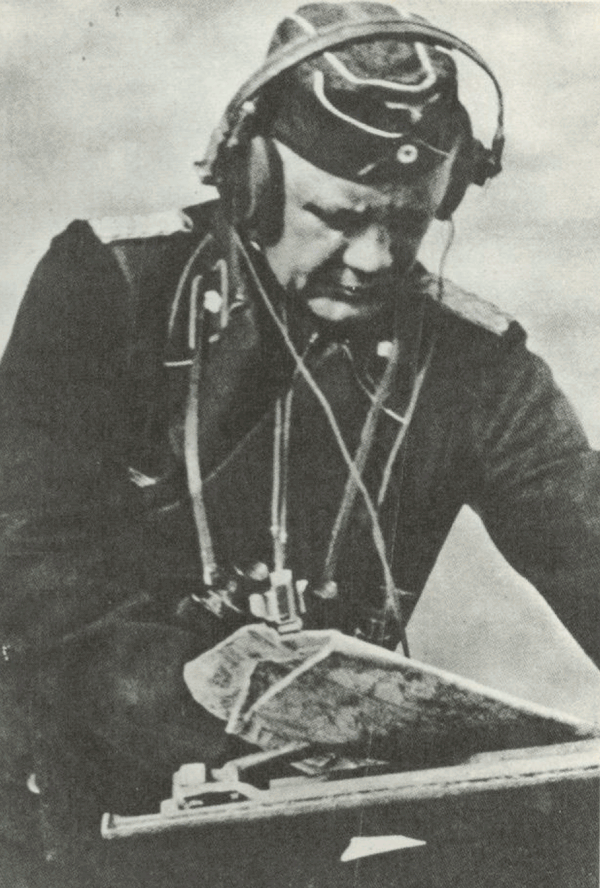
A Panzer major studies his maps, slightly hampered by the cables and straps of earphones, throat microphones and field-glasses. Note silver-piped sidecap.
E3 Zeugmeister Unterfeldwebel, Panzergrenadier, 1942
An N.C.O. - the rank corresponds roughly to sergeant - preparing to go out on the town while on leave. For 'walking out', the service tunic (Heeres Dienstanzug) was in practice worn much more frequently than the Waffenrock illustrated in Plate A1, although the latter was intended for walking out as well as parade wear.
The Schirmmütze for non-commissioned personnel is basically similar to the officer's model, although of poorer quality; the crown is smaller, the silver cords of the officer are replaced by a black gloss-leather chinstrap, and the badges are in a duller silver-grey alloy. The colours are the same, however; field-grey crown, dark-green band, and Waffenfarbe piping - in this case, the green of the armoured infantry. The 1936 service tunic with the dark-green collar is worn buttoned to the throat with this order of dress. The 9mm-wide silver braid distinguishes all ranks from Unteroffizier upwards, and reappears on the shoulder-straps; the braid follows the edge of the straps 'on all three sides', identifying the wearer's exact rank. The usual national emblem appears above the right breast-pocket, and the ribbon of the Iron Cross 2nd Class is worn in the second buttonhole. The six small eyelets in the front (and back) of the tunic are for the removable brass belt-hooks, normally fitted when field equipment is being worn, to help support the weight of the belt. Above the left breast-pocket are medal ribbons marking the soldier's service on the West Wall and in the first winter in Russia - the latter usually referred to as 'The Order of the Frozen Meat'. The bronze badge on the pocket is the SA Sports Badge, won during the soldier's prewar membership of the Sturmabteilungen or Storm Troopers. He wears no Assault Badge; his trade badge, the cloth insignia on the right forearm, identifies him as Zeugmeister - a clothing store N.C.O.! His Iron Cross is no doubt a memento of some unexpected encounter in the Russian winter, when Zhukov's Siberians penetrated deep behind German lines.
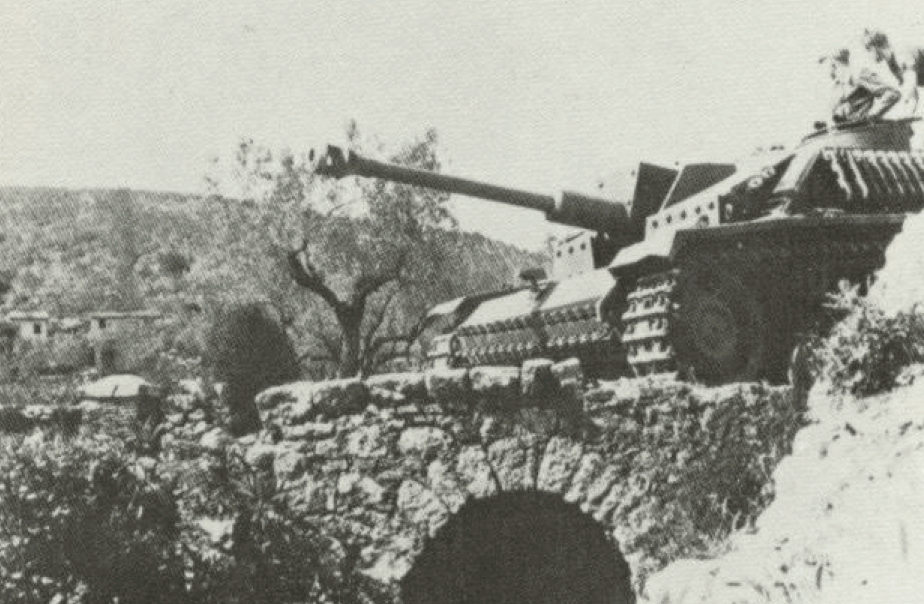
The StuG III assault gun, one of several types of 'SP' produced in great numbers in the last two years of the war in an effort to make up Panzer division losses quickly. (Imperial War Museum)
The usual issue belt is worn, and for walking out the bayonet is decorated with the Army N.C.O.'s green and silver brocade Troddel or side-arm knot. Trousers and laced shoes are worn with this order.
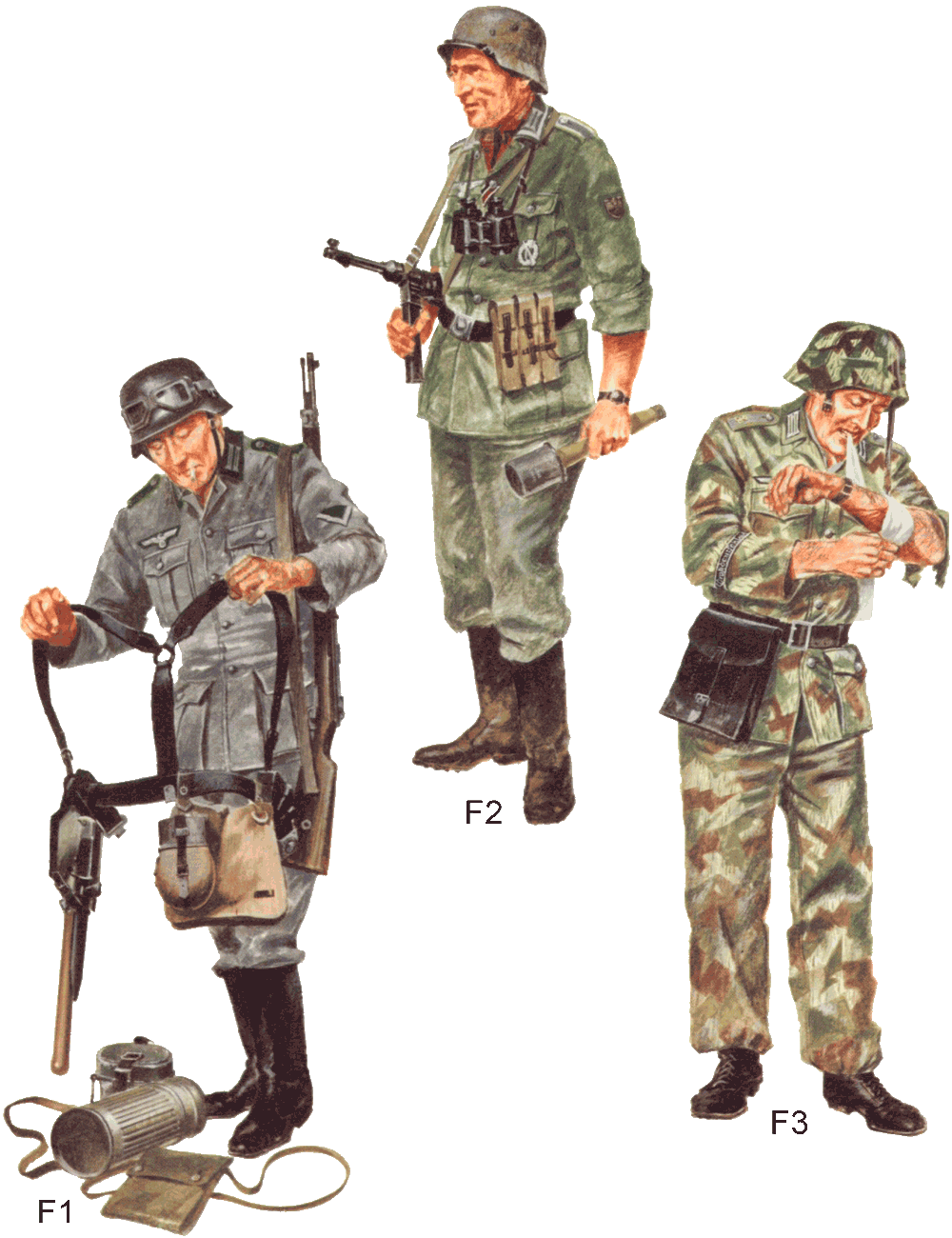
F1 Gefreiter, Panzergrenadier, 1940
The typical soldier, and his field equipment. He wears the grey-painted 1935 steel helmet, with a black shield decal with a white eagle and swastika motif on the left side, and a black/white/red diagonally divided tricolor shield decal on the right. Every soldier was issued with a pair of simple dust and smoke goggles, usually pushed up on to the helmet when not required. The 1936 service tunic with dark-green collar and shoulder- straps is worn open at the neck when in the field. The usual national emblem is sewn above the right pocket, and the chevron of rank on the left upper arm. There are no other insignia. The rather loose trousers are tucked in standard issue marching boots.
This lance-corporal is sorting out his discarded kit after a rest on the march. His Mauser K.98 7-92 mm service rifle is slung on his shoulder for the moment. At his feet are his mess tin, his fluted gas-mask canister (normally worn behind the left hip, slung round the body on a webbing strap), and the cotton bag for his anti-gas cape, normally slung on the chest. The belt and Y-strap harness support six pouches for rifle ammunition, three on each side of the buckle; a canvas 'bread bag' for rations and small kit; a quart-capacity felt-covered canteen, with cup; an entrenching spade reversed in a leather case; and the Mauser bayonet.
We have much more interesting information on this site.
Click MENU to check it out!
∎ cartalana.com© 2009-2025 ∎ mailto: cartalana@cartalana.com